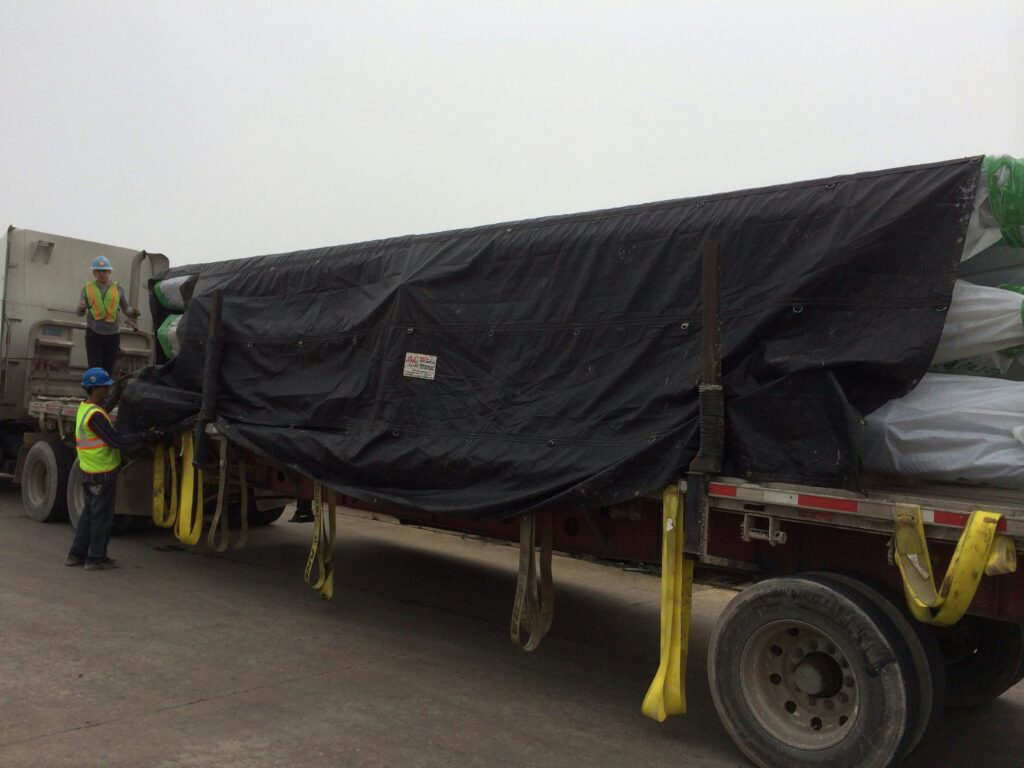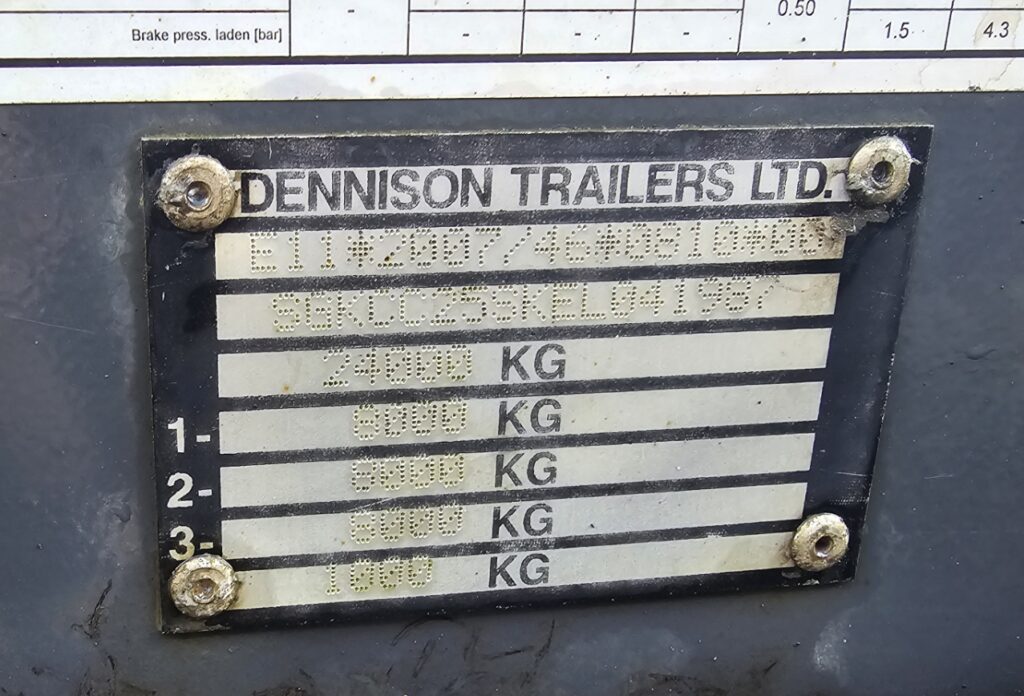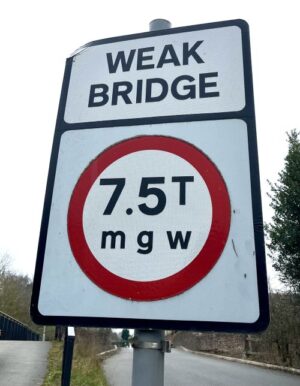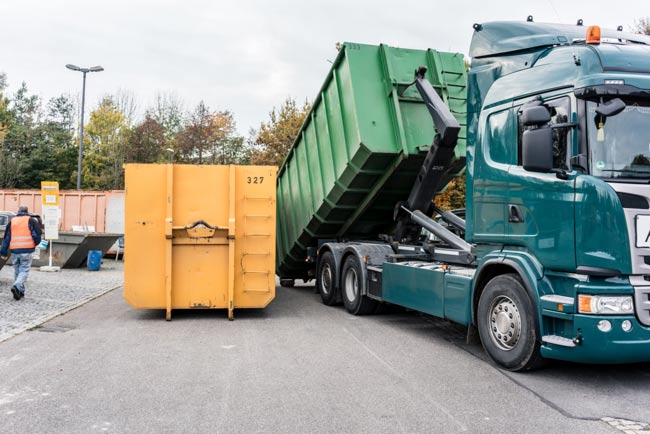For a Heavy Goods Vehicle to drive legally on a road, the vehicle has to comply with permitted weights and dimensions.
There are different set limits for roads within the UK and the EU, which must be adhered to if a journey involves travel within and across borders. National governments can set their own limits for domestic journeys.
Whilst we’re not able to provide specific advice on vehicle weight plates, all the information you need has been collated in the following article. Be sure to check out the download and resources section for more info,. If you have any enquiries we recommend that you contact DVSA or your vehicle manufacturer in the first instance.
Plated weights
In the UK, all HGVs must display a permanently fixed Department for Transport (DfT) and/or Ministry plate that shows both the permitted axle and gross weights for that vehicle. A plating certificate is a document required by HGVs above 3500kg gross weight, that accompanies the plate and stays with a vehicle or trailer for life – it should be available for inspection at all times.
The DVSA website has internet accessible versions of application forms for recording the details of a new HGV which can be found here. A vehicle must be registered with the DVLA by either the dealer who sold the vehicle or the new owner, before it is registered with the DVSA in order to obtain a ministry plate (and plating certificate if needed) and so that it can be booked for an MOT test.
DfT weight plates are fitted on a vehicle when it is first registered but must be amended if a vehicle is modified. They will be fitted to a trailer when it has gone through its first annual DfT test. There is no fee required when first recording a vehicle’s details with the DVSA however a scale of fees is applicable when a vehicle’s weight plate details change. This fee varies according to the number of axles and the type of test required. A full list of fees can be found here.
HGV Weight Plate Categories
In the UK there are 2 types of plating that are acceptable on HGVs – ‘manufacturers’ plating and ‘ministry’ plating.
‘Manufacturers’ plating:
Except in a very few cases, all goods vehicles must be equipped with a ‘manufacturers plate’ which, along with other details, must display the name of the manufacturer and the maximum axle, gross and train weights at which the vehicle is designed to operate.
‘Ministry’ plating or DVSA certificate (formerly the VOSA plating certificate):
The ministry plate or plating certificate can be issued by DVSA to goods vehicles above 3500kg gross weight. It denotes the potential maximum legal weight of the vehicle. In GB the ‘plate’ is usually carried in the cab of heavy goods vehicles or attached to the trailer chassis in the case of heavy trailers.
In any case, the maximum weights specified on either the vehicle’s manufacturers plate’ or ‘ministry plate’ must not be exceeded. If you are unsure which weights on either of these plates must not be exceeded, the vehicle manufacturer or DVSA are likely to be best placed to provide advice.
Goods vehicles over 3,500kg gross weight must have a plate fitted to the cab showing the vehicle manufacturer, vehicle type, engine type, power, VIN number, number of axles, maximum design weight and the plated weight.
Goods vehicles below 3,500kg gross weight are not required to be fitted with a plate.
Trailers over 1,020kg unladen weight must have a fitted plate showing the trailer manufacturer, chassis number, number of axles, the maximum load imposed on the towing vehicle, year of manufacturer, the maximum design weight and maximum plated weight.
It should be noted that the VOSA plating certificate was superseded by the DVSA plating certificate in late 2013 when the Vehicle and Operators Service Agency (VOSA) was merged with the Driving Standards Agency (DSA) and became known as the DVSA.
Definitions
There are a number of different weights and dimensions that apply to HGVs:
- Gross Vehicle Weight (GVW): maximum legally permitted weight of the vehicle plus its load
- Gross Train Weight (GTW): total weight of tractor unit plus trailer and load. Also known as the Gross Combination Weight (GCW)
- Maximum Authorised Mass (MAM): permissible maximum weight, used on the vehicle plate
Overloading
The weight limits displayed on an HGV weight plate (either the manufacturers’ plate or ministry plate) are defined by the technical specification of the vehicle. The set limits exist to protect roads and bridges from excessive wear.
In exceptional cases vehicles can be permitted to operate at weights over 44 tonnes (such as when moving abnormal indivisible loads). However special provisions are in place to deal with such situations, which can be found in the Road Vehicles (Authorisation of Special Types) (General) Order 2003.
When is a vehicle overloaded?

A vehicle is overloaded if it exceeds the weight limits displayed on either the manufacturers’ or ministry plates. A vehicle could be overloaded on its axle(s), gross and train weight. Each of these would be classed as separate offences, making both the vehicle operator and the driver liable for each offence.
e.g. a 3-axle articulated vehicle exceeding the plated weights on the 1st axle, 2nd axle and gross weight would make both the vehicle operator and driver liable to three separate offences.
The consequences of overloading a vehicle are many fold. Should a vehicle exceed its design weight it will have longer stopping distances which has implications for road safety, excess weight will have a disproportionately increased impact on road wear, and an operator who is overloading vehicles will gain an unfair advantage over their competitors who are not carrying excess loads.
For these reasons, the DVSA, police and trading standards work hard to enforce HGV weights and limits, with frequent weighing (planned and roadside spot checks) taking place. Where a breach of the regulations is identified, both the operator and driver risk prosecution. In addition, where a conviction of overloading is made it could also lead to disciplinary action from the Traffic Commissioner against the operator’s licence.
MHF (UK) Ltd recommends that HGV operators and drivers are fully aware of safe loading practices. Read more in our article on UK loading regulations and load security here.
What are the laws applicable to HGV weight plates and limits?
Goods vehicles in the UK must adhere to certain criteria with regard to the weight and limits they fall within as dictated by the Road Vehicles (Construction & Use) Regulations 1986 as amended (C&U) and the Road Vehicles (Authorised Weight) Regulations 1998 as amended (AWR).
HGV maximum weights and limits enforceable by law within the UK can be found in full (with footnotes) here.
The UK Government website also contains a useful guide to lorry types and weights, which is available here.
In the EU, vehicles must comply with Directive (EU) 2015/719 which supersedes Directive 96/53/EC. Details including other directives that complement this can be found at EUR-Lex – 32015L0719 – EN – EUR-Lex (europa.eu).
Further details about permissible weights and dimensions on roads within the EU can be found at Weights and dimensions | Mobility and Transport (europa.eu).
What is Downplating?
Where a vehicle is unlikely to carry its potential maximum weight, an owner can apply to reduce the weight that the vehicle is allowed to carry. This is known as downplating and can reduce the tax or vehicle excise duty (VED) owed. There may not be a need for any mechanical alterations to be made but it is essential that an application is made to the DVSA via form VTG10 Notifiable Alterations along with the appropriate fee. Form VTG10 can be obtained from APPLICATION FOR PSV ACCESSIBILITY CERTIFICATE PSVA 1 (publishing.service.gov.uk) or from a goods vehicle testing station.
Should circumstances change and the vehicle is needed to carry its original maximum weight once again, downplating can be reversed. This would result in the vehicle being uprated. A situation where this might happen could be where a vehicle has been bought by a new owner who wishes to use it at its original permitted weight.
In some instances a vehicle may require mechanical alterations in order to be downplated. This is called Downrating as it physically changes the design capacity of a vehicle.
What is a notifiable alteration?
A Notifiable Alteration is notification of a change of vehicle specification, or plating details, i.e. changes to: vehicle registration (cherished transfer), vehicle body, tyre sizes, brake systems, fixed equipment, weight changes etc.
Further information on weight plates
Detailed information and guidance about HGV plates, downrating, uprating and notifiable alterations can be found by contacting the DVSA helpline on 0300 123 9000. Additional information will also be available from the relevant vehicle manufacturer if you have a query that relates to a specific vehicle.
Useful downloads and resources
The websites that have been referred to in this document can also be found here for ease of reference:
- Driver and Vehicle Standards Agency
- Replace HGV plating or test documents
- Heavy goods vehicle (HGV) and trailer test fees
- HGV maximum weights
- The Road Vehicles (Construction and Use) Regulations 1986 (original version)
- Guide to lorry types and weights
- EUR-Lex – 32015L0719 – EN – EUR-Lex
- Weights and dimensions | Mobility and Transport
- APPLICATION FOR PSV ACCESSIBILITY CERTIFICATE PSVA 1
- Change an HGV plated details or notify alterations
Frequently Asked Questions
Where can I find official guidance on HGV weight plates in the UK?
You can find official guidance on HGV weight plates on the UK government website, particularly under the DVSA (Driver and Vehicle Standards Agency) section at https://www.gov.uk/transport/hgv-standards-and-checks. This includes information about legal weight limits, plate formats, and compliance rules.
How do I find out the weight of my HGV?
You can find the weight of your HGV by referring to the manufacturer’s plate and the Department for Transport (DfT) plate on the vehicle. For actual loaded weight, you can use a public weighbridge.
Who do I notify about alterations to my HGV?
Any significant alterations to your HGV must be reported to the DVSA (Driver and Vehicle Standards Agency) https://www.gov.uk/government/publications/details-of-notifiable-alterations-or-application-for-a-change-of-plated-details-of-a-goods-motor-vehicle. These changes may require inspection or re-certification to ensure the vehicle remains road legal.




